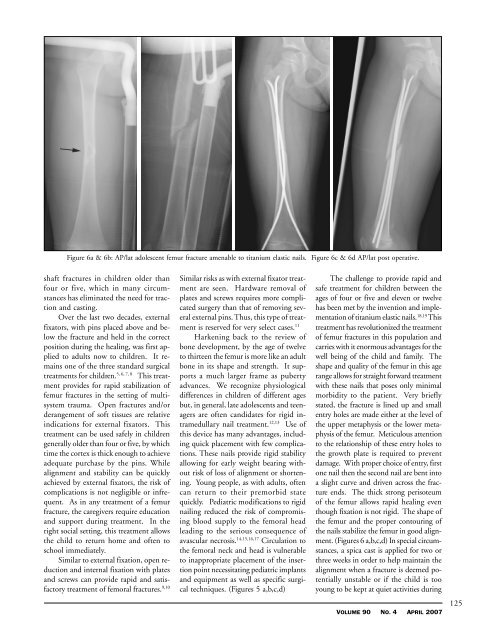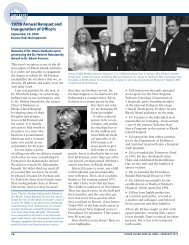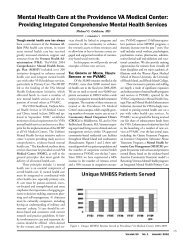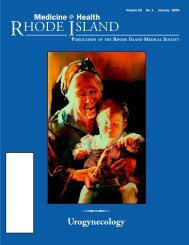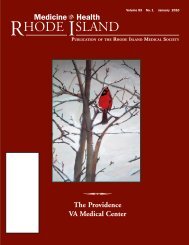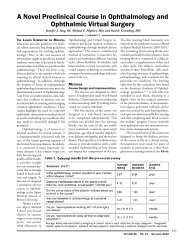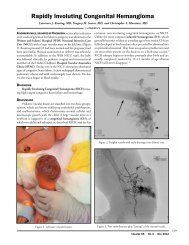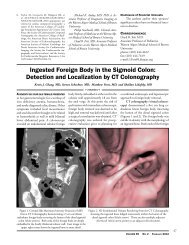April 2007 - Division of Biology and Medicine - Brown University
April 2007 - Division of Biology and Medicine - Brown University
April 2007 - Division of Biology and Medicine - Brown University
You also want an ePaper? Increase the reach of your titles
YUMPU automatically turns print PDFs into web optimized ePapers that Google loves.
Figure 6a & 6b: AP/lat adolescent femur fracture amenable to titanium elastic nails. Figure 6c & 6d AP/lat post operative.<br />
shaft fractures in children older than<br />
four or five, which in many circumstances<br />
has eliminated the need for traction<br />
<strong>and</strong> casting.<br />
Over the last two decades, external<br />
fixators, with pins placed above <strong>and</strong> below<br />
the fracture <strong>and</strong> held in the correct<br />
position during the healing, was first applied<br />
to adults now to children. It remains<br />
one <strong>of</strong> the three st<strong>and</strong>ard surgical<br />
treatments for children. 5, 6, 7, 8 This treatment<br />
provides for rapid stabilization <strong>of</strong><br />
femur fractures in the setting <strong>of</strong> multisystem<br />
trauma. Open fractures <strong>and</strong>/or<br />
derangement <strong>of</strong> s<strong>of</strong>t tissues are relative<br />
indications for external fixators. This<br />
treatment can be used safely in children<br />
generally older than four or five, by which<br />
time the cortex is thick enough to achieve<br />
adequate purchase by the pins. While<br />
alignment <strong>and</strong> stability can be quickly<br />
achieved by external fixators, the risk <strong>of</strong><br />
complications is not negligible or infrequent.<br />
As in any treatment <strong>of</strong> a femur<br />
fracture, the caregivers require education<br />
<strong>and</strong> support during treatment. In the<br />
right social setting, this treatment allows<br />
the child to return home <strong>and</strong> <strong>of</strong>ten to<br />
school immediately.<br />
Similar to external fixation, open reduction<br />
<strong>and</strong> internal fixation with plates<br />
<strong>and</strong> screws can provide rapid <strong>and</strong> satisfactory<br />
treatment <strong>of</strong> femoral fractures. 9,10<br />
Similar risks as with external fixator treatment<br />
are seen. Hardware removal <strong>of</strong><br />
plates <strong>and</strong> screws requires more complicated<br />
surgery than that <strong>of</strong> removing several<br />
external pins. Thus, this type <strong>of</strong> treatment<br />
is reserved for very select cases. 11<br />
Harkening back to the review <strong>of</strong><br />
bone development, by the age <strong>of</strong> twelve<br />
to thirteen the femur is more like an adult<br />
bone in its shape <strong>and</strong> strength. It supports<br />
a much larger frame as puberty<br />
advances. We recognize physiological<br />
differences in children <strong>of</strong> different ages<br />
but, in general, late adolescents <strong>and</strong> teenagers<br />
are <strong>of</strong>ten c<strong>and</strong>idates for rigid intramedullary<br />
nail treatment. 12,13 Use <strong>of</strong><br />
this device has many advantages, including<br />
quick placement with few complications.<br />
These nails provide rigid stability<br />
allowing for early weight bearing without<br />
risk <strong>of</strong> loss <strong>of</strong> alignment or shortening.<br />
Young people, as with adults, <strong>of</strong>ten<br />
can return to their premorbid state<br />
quickly. Pediatric modifications to rigid<br />
nailing reduced the risk <strong>of</strong> compromising<br />
blood supply to the femoral head<br />
leading to the serious consequence <strong>of</strong><br />
avascular necrosis. 14,15,16,17 Circulation to<br />
the femoral neck <strong>and</strong> head is vulnerable<br />
to inappropriate placement <strong>of</strong> the insertion<br />
point necessitating pediatric implants<br />
<strong>and</strong> equipment as well as specific surgical<br />
techniques. (Figures 5 a,b,c,d)<br />
The challenge to provide rapid <strong>and</strong><br />
safe treatment for children between the<br />
ages <strong>of</strong> four or five <strong>and</strong> eleven or twelve<br />
has been met by the invention <strong>and</strong> implementation<br />
<strong>of</strong> titanium elastic nails. 18,19 This<br />
treatment has revolutionized the treatment<br />
<strong>of</strong> femur fractures in this population <strong>and</strong><br />
carries with it enormous advantages for the<br />
well being <strong>of</strong> the child <strong>and</strong> family. The<br />
shape <strong>and</strong> quality <strong>of</strong> the femur in this age<br />
range allows for straight forward treatment<br />
with these nails that poses only minimal<br />
morbidity to the patient. Very briefly<br />
stated, the fracture is lined up <strong>and</strong> small<br />
entry holes are made either at the level <strong>of</strong><br />
the upper metaphysis or the lower metaphysis<br />
<strong>of</strong> the femur. Meticulous attention<br />
to the relationship <strong>of</strong> these entry holes to<br />
the growth plate is required to prevent<br />
damage. With proper choice <strong>of</strong> entry, first<br />
one nail then the second nail are bent into<br />
a slight curve <strong>and</strong> driven across the fracture<br />
ends. The thick strong perisoteum<br />
<strong>of</strong> the femur allows rapid healing even<br />
though fixation is not rigid. The shape <strong>of</strong><br />
the femur <strong>and</strong> the proper contouring <strong>of</strong><br />
the nails stabilize the femur in good alignment.<br />
(Figures 6 a,b,c,d) In special circumstances,<br />
a spica cast is applied for two or<br />
three weeks in order to help maintain the<br />
alignment when a fracture is deemed potentially<br />
unstable or if the child is too<br />
young to be kept at quiet activities during<br />
VOLUME 90 NO. 4 APRIL <strong>2007</strong><br />
125


